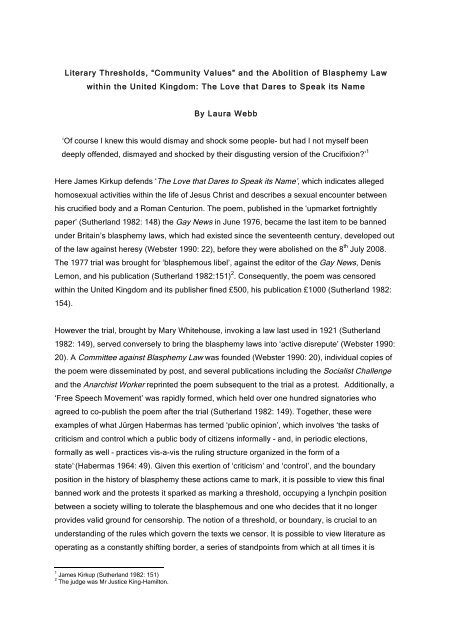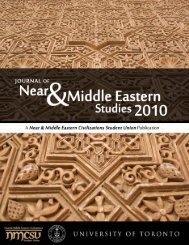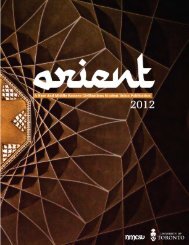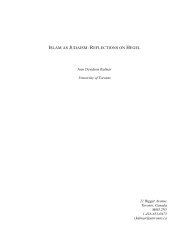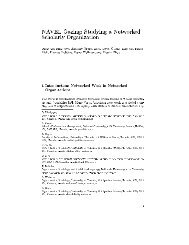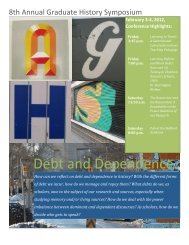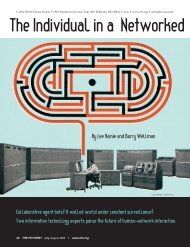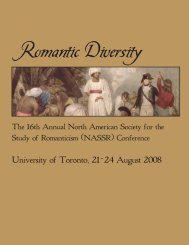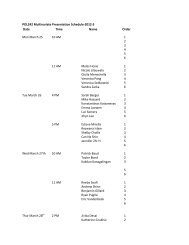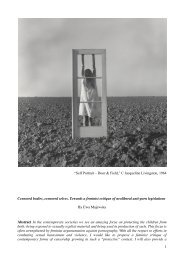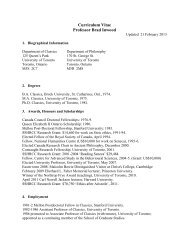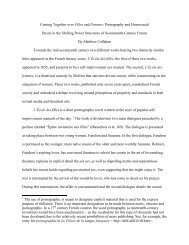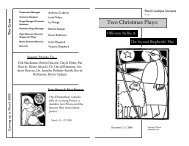and the Abolition of Blasphemy Law within the United Kingdom
and the Abolition of Blasphemy Law within the United Kingdom
and the Abolition of Blasphemy Law within the United Kingdom
Create successful ePaper yourself
Turn your PDF publications into a flip-book with our unique Google optimized e-Paper software.
Literary Thresholds, “Community Values” <strong>and</strong> <strong>the</strong> <strong>Abolition</strong> <strong>of</strong> <strong>Blasphemy</strong> <strong>Law</strong><br />
<strong>within</strong> <strong>the</strong> <strong>United</strong> <strong>Kingdom</strong>: The Love that Dares to Speak its Name<br />
By Laura Webb<br />
‘Of course I knew this would dismay <strong>and</strong> shock some people- but had I not myself been<br />
deeply <strong>of</strong>fended, dismayed <strong>and</strong> shocked by <strong>the</strong>ir disgusting version <strong>of</strong> <strong>the</strong> Crucifixion’ 1<br />
Here James Kirkup defends ‘The Love that Dares to Speak its Name’, which indicates alleged<br />
homosexual activities <strong>within</strong> <strong>the</strong> life <strong>of</strong> Jesus Christ <strong>and</strong> describes a sexual encounter between<br />
his crucified body <strong>and</strong> a Roman Centurion. The poem, published in <strong>the</strong> ‘upmarket fortnightly<br />
paper’ (Su<strong>the</strong>rl<strong>and</strong> 1982: 148) <strong>the</strong> Gay News in June 1976, became <strong>the</strong> last item to be banned<br />
under Britain’s blasphemy laws, which had existed since <strong>the</strong> seventeenth century, developed out<br />
<strong>of</strong> <strong>the</strong> law against heresy (Webster 1990: 22), before <strong>the</strong>y were abolished on <strong>the</strong> 8 th July 2008.<br />
The 1977 trial was brought for ‘blasphemous libel’, against <strong>the</strong> editor <strong>of</strong> <strong>the</strong> Gay News, Denis<br />
Lemon, <strong>and</strong> his publication (Su<strong>the</strong>rl<strong>and</strong> 1982:151) 2 . Consequently, <strong>the</strong> poem was censored<br />
<strong>within</strong> <strong>the</strong> <strong>United</strong> <strong>Kingdom</strong> <strong>and</strong> its publisher fined £500, his publication £1000 (Su<strong>the</strong>rl<strong>and</strong> 1982:<br />
154).<br />
However <strong>the</strong> trial, brought by Mary Whitehouse, invoking a law last used in 1921 (Su<strong>the</strong>rl<strong>and</strong><br />
1982: 149), served conversely to bring <strong>the</strong> blasphemy laws into ‘active disrepute’ (Webster 1990:<br />
20). A Committee against <strong>Blasphemy</strong> <strong>Law</strong> was founded (Webster 1990: 20), individual copies <strong>of</strong><br />
<strong>the</strong> poem were disseminated by post, <strong>and</strong> several publications including <strong>the</strong> Socialist Challenge<br />
<strong>and</strong> <strong>the</strong> Anarchist Worke reprinted <strong>the</strong> poem subsequent to <strong>the</strong> trial as a protest. Additionally, a<br />
‘Free Speech Movement’ was rapidly formed, which held over one hundred signatories who<br />
agreed to co-publish <strong>the</strong> poem after <strong>the</strong> trial (Su<strong>the</strong>rl<strong>and</strong> 1982: 149). Toge<strong>the</strong>r, <strong>the</strong>se were<br />
examples <strong>of</strong> what Jürgen Habermas has termed ‘public opinion’, which involves ‘<strong>the</strong> tasks <strong>of</strong><br />
criticism <strong>and</strong> control which a public body <strong>of</strong> citizens informally - <strong>and</strong>, in periodic elections,<br />
formally as well - practices vis-a-vis <strong>the</strong> ruling structure organized in <strong>the</strong> form <strong>of</strong> a<br />
state’ . (Habermas 1964: 49). Given this exertion <strong>of</strong> ‘criticism’ <strong>and</strong> ‘control’, <strong>and</strong> <strong>the</strong> boundary<br />
position in <strong>the</strong> history <strong>of</strong> blasphemy <strong>the</strong>se actions came to mark, it is possible to view this final<br />
banned work <strong>and</strong> <strong>the</strong> protests it sparked as marking a threshold, occupying a lynchpin position<br />
between a society willing to tolerate <strong>the</strong> blasphemous <strong>and</strong> one who decides that it no longer<br />
provides valid ground for censorship. The notion <strong>of</strong> a threshold, or boundary, is crucial to an<br />
underst<strong>and</strong>ing <strong>of</strong> <strong>the</strong> rules which govern <strong>the</strong> texts we censor. It is possible to view literature as<br />
operating as a constantly shifting border, a series <strong>of</strong> st<strong>and</strong>points from which at all times it is<br />
1<br />
James Kirkup (Su<strong>the</strong>rl<strong>and</strong> 1982: 151)<br />
2<br />
The judge was Mr Justice King-Hamilton.
possible to ei<strong>the</strong>r assemble, or withdraw. Seamus Heaney has described poetry as ‘...more <strong>of</strong> a<br />
threshold than a path, one constantly approached <strong>and</strong> constantly departed from, at which reader<br />
<strong>and</strong> writer undergo in <strong>the</strong>ir different ways <strong>the</strong> experience <strong>of</strong> being at <strong>the</strong> same time summoned<br />
<strong>and</strong> released’ (Heaney 2002: 190). The factors implicit in this boundary-marking are spatially <strong>and</strong><br />
temporally dependent. DH <strong>Law</strong>rence determined <strong>the</strong> temporal as a negotiating factor:<br />
Man is a changeable beast, <strong>and</strong> words change <strong>the</strong>ir meanings with him, <strong>and</strong> things<br />
are not what <strong>the</strong>y seemed, <strong>and</strong> what’s what becomes what is not, <strong>and</strong> if we think we<br />
know where we are it’s only because we are so rapidly being translated to<br />
somewhere else. (<strong>Law</strong>rence 1955: 196)<br />
Over time <strong>the</strong>n, not <strong>the</strong> texts <strong>the</strong>mselves- which largely remain stable-, but our perception <strong>of</strong><br />
<strong>the</strong>m, shifts, <strong>of</strong>ten as we move towards increasingly liberal or conservative societies. This<br />
explains why different countries have vastly distinct regulations regarding <strong>the</strong> blasphemous in <strong>the</strong><br />
same historical epoch. Each given “community” or jurisdiction sets its own rules, not necessarily<br />
by majority, but according to <strong>the</strong> beliefs <strong>of</strong> those in power, <strong>and</strong> by those whom <strong>Law</strong>rence termed<br />
‘<strong>the</strong> mob’ (<strong>Law</strong>rence 1955: 196). Mat<strong>the</strong>w Kieran has stressed <strong>the</strong> spatial <strong>and</strong> geographicalcultural<br />
variation factor in items deemed obscene, ‘explained by <strong>the</strong> socio-cultural variance in<br />
what is internalized as morally prohibited’ (Kieran 2002: 53). These geographical <strong>and</strong> cultural<br />
boundaries have been problematized by <strong>the</strong> invention <strong>of</strong> <strong>the</strong> internet. In Kirkup’s case,<br />
subsequent to <strong>the</strong> invention <strong>of</strong> <strong>the</strong> internet at <strong>the</strong> end <strong>of</strong> <strong>the</strong> 1980’s, <strong>the</strong> poem was available<br />
online, although publishing <strong>the</strong> poem in this way none<strong>the</strong>less technically constituted a violation <strong>of</strong><br />
<strong>the</strong> law. This was a consequence <strong>of</strong> <strong>the</strong> new problem <strong>of</strong> nationally censoring texts which had<br />
become available internationally via virtual means. Some web-pages which made available<br />
Kirkup’s poem stated alongside it that <strong>the</strong>y were hosted on non-UK servers, <strong>and</strong> as such,<br />
although accessible <strong>within</strong> Britain, fell outside <strong>the</strong> remits <strong>of</strong> British law (Gamaliel 2002). As<br />
Herumin explains, ‘<strong>the</strong> global nature <strong>of</strong> <strong>the</strong> internet raises complex questions for many<br />
governments’ (Herumin 2004: 17-18). It is impossible to overstate <strong>the</strong> capacity <strong>of</strong> <strong>the</strong> internet to<br />
transport material across communities <strong>and</strong> community boundaries.<br />
Britain’s 2008 abolition <strong>of</strong> <strong>the</strong> blasphemy laws can be viewed as a sign <strong>of</strong> a British twentiethcentury<br />
fragmentation <strong>of</strong> identity <strong>of</strong> which <strong>the</strong> internet is a symbol, as well as a contributing factor.<br />
The decline in Christianity <strong>and</strong> patriotism - <strong>and</strong> simultaneous rise <strong>of</strong> more individual-centred<br />
activities such as <strong>the</strong> internet, which provide us with a more precise personal expression - have<br />
served as causes <strong>of</strong> an increasingly polylithic culture. The contemporary waning popularity <strong>of</strong> <strong>the</strong><br />
linked concepts <strong>of</strong> nationhood <strong>and</strong> religion (Webster 1990: 23-24) has warranted during <strong>the</strong> last<br />
one hundred years a decreased plausibility for blasphemy laws which, as described in a 1922<br />
pamphlet by Chapman Cohen entitled <strong>Blasphemy</strong>- A Plea for Religious Equality:
...belong to a period... when it was <strong>the</strong> duty <strong>of</strong> <strong>the</strong> State to enforce <strong>and</strong> openly<br />
coerce opinion. They are also part <strong>of</strong> <strong>the</strong> general belief that <strong>the</strong> right discharge <strong>of</strong> <strong>the</strong><br />
duties <strong>of</strong> citizenship depends in some more or less obscure way on <strong>the</strong> holding <strong>of</strong><br />
right religious beliefs… Unbelief, heresy <strong>and</strong> blasphemy partake <strong>of</strong> <strong>the</strong> nature <strong>of</strong><br />
treason, <strong>the</strong> heretic is one who is a threat to <strong>the</strong> welfare <strong>of</strong> <strong>the</strong> tribe or nation, <strong>and</strong>, in<br />
<strong>the</strong> interests <strong>of</strong> <strong>the</strong> whole group, he must be suppressed. (Cohen in Webster 1990:<br />
21)<br />
Such debate became possible in Britain around <strong>the</strong> time <strong>of</strong> <strong>the</strong> Protestant Reformation, when <strong>the</strong><br />
organised Church split. As Webster has explained, as opposed to <strong>the</strong> previously heavy external<br />
authority <strong>of</strong> <strong>the</strong> established Church, Protestants, <strong>and</strong> especially, slightly later, <strong>the</strong> Puritans, now<br />
took Christianity into <strong>the</strong>ir own h<strong>and</strong>s, reconsidering what had previously been accepted as plain<br />
fact, <strong>and</strong> in <strong>the</strong>ir more precise interpretation <strong>of</strong> <strong>the</strong> Bible demonstrating an internalisation <strong>of</strong> <strong>the</strong>ir<br />
belief, which cleared space for both an alternative interpretation <strong>of</strong> key Christian texts, <strong>and</strong> <strong>the</strong><br />
manner in which Christianity ought to operate (Webster 1990: 28) 3 . Webster has gone so far as<br />
to call this a ‘conscience-centred revolution’ (Webster 1990: 30).<br />
This newly fragmented society <strong>of</strong> <strong>the</strong> 16 th century, one in which <strong>the</strong> established Church <strong>and</strong><br />
monarchy had lost popular ground, was one that gave less credence to <strong>the</strong> authoritative figures<br />
<strong>of</strong> its religion than <strong>the</strong> society which had preceded it. In particular, amongst Puritans, heresy<br />
against figureheads such as <strong>the</strong> Pope, whom <strong>the</strong>y considered a false idol, was common as a<br />
means <strong>of</strong> discrediting <strong>the</strong> older system <strong>of</strong> belief (Webster 1990: 29). Heretical statements were<br />
now spoken by Christians against o<strong>the</strong>r Christians, <strong>and</strong> this rise in heresy would eventually lead<br />
to a rise in <strong>the</strong> more serious crime <strong>of</strong> blasphemy as, over <strong>the</strong> next three hundred years,<br />
Christianity in its now diverse forms came to hold an increasingly weak grasp on <strong>the</strong> national<br />
conscience. The authority <strong>of</strong> <strong>the</strong> individual conscience had much to gain from this radical<br />
fragmentation <strong>of</strong> <strong>the</strong> unity <strong>of</strong> <strong>the</strong> Church, <strong>and</strong> this had far-reaching <strong>and</strong> long-term consequences.<br />
A schism had been opened up in a hi<strong>the</strong>rto impermeable Church structure which would continue<br />
to deepen throughout <strong>the</strong> Enlightenment <strong>and</strong> into contemporary society. Regarding <strong>the</strong> situation<br />
in Britain in 1990, Webster writes<br />
A ... telling perspective on <strong>the</strong> status <strong>of</strong> blasphemy is <strong>of</strong>fered if we consider <strong>the</strong><br />
manner in which in our once <strong>the</strong>ocratic state, <strong>the</strong> authority <strong>of</strong> <strong>the</strong> individual<br />
conscience has gradually been afforded <strong>the</strong> same position <strong>and</strong> been veiled with <strong>the</strong><br />
same sanctity, as <strong>the</strong> authority <strong>of</strong> <strong>the</strong> Scriptures in earlier centuries. (Webster 1990:<br />
28)<br />
3<br />
As expressed by John Milton, ‘If a particular passage <strong>of</strong> <strong>the</strong> scriptures could not be reconciled with <strong>the</strong> case <strong>of</strong> human or moral<br />
good, <strong>the</strong>n it was to be rejected’ (Webster 1990: 28).
In 1976 however, <strong>the</strong> blasphemy <strong>of</strong> <strong>the</strong> text in <strong>the</strong> eyes <strong>of</strong> <strong>the</strong> law was upheld. Within <strong>the</strong><br />
legal ‘community’, <strong>the</strong> notion <strong>of</strong> a boundary or threshold is also central to <strong>the</strong> censorship<br />
debate. Moran has stressed ‘<strong>the</strong> importance <strong>of</strong> ‘border’ <strong>and</strong> ‘boundary’ that connote <strong>the</strong><br />
fixibility <strong>and</strong> stability <strong>of</strong> <strong>the</strong> spatial distribution <strong>of</strong> law <strong>and</strong> crime, order <strong>and</strong> disorder, law <strong>and</strong><br />
literature, through <strong>the</strong> distinction between decent <strong>and</strong> indecent texts. As a ‘border’ <strong>and</strong><br />
a ’boundary’, <strong>the</strong> conventions <strong>of</strong> textual civility are presented in <strong>the</strong>ir relation to an ‘o<strong>the</strong>r’<br />
(Moran 2001: 154). From <strong>the</strong> verdict <strong>of</strong> <strong>the</strong> 1976 trial, it is clear that Kirkup <strong>and</strong> Lemon<br />
were perceived <strong>and</strong> judged as having endorsed this ‘o<strong>the</strong>r’, in this act having crossed a<br />
threshold legally, patriotically <strong>and</strong> religiously. As any ‘alternative’ or ‘o<strong>the</strong>r’ reading <strong>of</strong> <strong>the</strong><br />
poem went unaddressed - <strong>the</strong> trial ignored <strong>the</strong> comparison drawn <strong>within</strong> <strong>the</strong> poem between<br />
Christ’s suffering <strong>and</strong> same sex love - (Moran 2001: 161), so too did any metaphoric<br />
implication this could have for <strong>the</strong> redemption <strong>of</strong> same sex lovers. Moran also discusses<br />
how in <strong>the</strong> courtroom, <strong>the</strong> dangerous letters <strong>of</strong> <strong>the</strong> poem were turned into ‘dead letters’ by<br />
<strong>the</strong> jury’s refusal to read <strong>the</strong> poem (or any portion <strong>of</strong> it) out in court, instead reducing it to<br />
mere summary (Moran 2001: 156), couched in legal <strong>and</strong> scientific terminology (Moran<br />
2001: 161), which favoured Whitehouse’s case as it stressed <strong>the</strong> value <strong>of</strong> ‘reason’- around<br />
which <strong>the</strong> law centres- as opposed to <strong>the</strong> poem’s ‘passion’, which <strong>the</strong> summary precluded<br />
(Moran 2001: 161-162). The present legal definition given by Halsbury’s <strong>Law</strong>s <strong>of</strong> Engl<strong>and</strong><br />
states that blasphemy consists <strong>of</strong> <strong>the</strong> ‘publication <strong>of</strong> contemptuous, reviling, scurrilous, or<br />
ludicrous matter relating to God, Jesus Christ, <strong>the</strong> Bible or <strong>the</strong> formularies <strong>of</strong> <strong>the</strong> Church <strong>of</strong><br />
Engl<strong>and</strong>.’ (Gregg 2002: 54) AS such, in <strong>the</strong> eyes <strong>of</strong> <strong>the</strong> court, <strong>the</strong> poem’s blasphemy was<br />
straightforward, indisputable <strong>and</strong> pervasive. Employing at times graphic description, <strong>the</strong><br />
poem states that Jesus partook <strong>of</strong> homosexual sex, oral <strong>and</strong> penetrative, both throughout<br />
his life <strong>and</strong> at <strong>the</strong> time <strong>of</strong> his death. It is possible too to suggest that as Jesus is only<br />
endowed with active verbs at <strong>the</strong> climax <strong>of</strong> <strong>the</strong> sex act, <strong>and</strong> afterwards, <strong>the</strong> act <strong>of</strong><br />
intercourse is portrayed as a central element in his resurrection:<br />
And after three long, lonely days, like years,<br />
...he rose from sleep, at dawn, <strong>and</strong> showed himself to me before<br />
all o<strong>the</strong>rs. And took me to him with<br />
<strong>the</strong> love that now forever dares to speak its name. (Kirkup 1976, emphasis mine)<br />
Additionally, <strong>the</strong> phrase ‘he crucified me with him into kingdom come’ (Kirkup: 1976) could be read<br />
to imply that <strong>the</strong> Centurion (metaphorically) died with Jesus, as such partaking in one <strong>of</strong> <strong>the</strong> most<br />
significant, sacred episodes <strong>of</strong> <strong>the</strong> Bible. Throughout, <strong>the</strong> poem adopts a casual tone <strong>and</strong><br />
sexually explicit lexis alongside overt religious reference, as when it names <strong>the</strong> sexual act at <strong>the</strong><br />
time <strong>of</strong> death ‘a miracle’, <strong>and</strong> in turns <strong>of</strong> phrase like
I knew he'd had it <strong>of</strong>f with o<strong>the</strong>r menwith<br />
Herod's guards, with Pontius Pilate,<br />
With John <strong>the</strong> Baptist, with Paul <strong>of</strong> Tarsus<br />
with foxy Judas, a great kisser, with<br />
<strong>the</strong> rest <strong>of</strong> <strong>the</strong> Twelve, toge<strong>the</strong>r <strong>and</strong> apart.<br />
He loved all men, body, soul <strong>and</strong> spirit... (Kirkup: 1976)<br />
Altoge<strong>the</strong>r, <strong>the</strong> blasphemy <strong>of</strong> <strong>the</strong> texts in <strong>the</strong> eyes <strong>of</strong> English law in 1976 was difficult to<br />
circumvent. However, although blasphemy <strong>and</strong> obscenity are distinct concepts both ontologically<br />
<strong>and</strong> legally, Su<strong>the</strong>rl<strong>and</strong> suggests that Whitehouse might have chosen to launch her prosecution<br />
under <strong>the</strong> blasphemy law as <strong>the</strong> means most likely <strong>of</strong> gaining a successful prosecution after<br />
obscenity had been protected under <strong>the</strong> 1959 Obscene Publications Act, stating that ‘deviant sex<br />
<strong>and</strong> blasphemy was a more combustible mixture than mere obscenity’ (Su<strong>the</strong>rl<strong>and</strong> 1982: 151-<br />
152), <strong>the</strong> perceived blasphemy <strong>of</strong> <strong>the</strong> text having been multiplied by its obscene nature. Certainly,<br />
certain elements <strong>of</strong> <strong>the</strong> text were perceived as ‘obscene’, in addition to purely blasphemous.<br />
Mat<strong>the</strong>w Kieran has identified objectification as an element <strong>of</strong> <strong>the</strong> obscene, to <strong>the</strong> extent that it<br />
‘de-humanizes’ people by representing <strong>the</strong>m as ‘mere objects, things, <strong>and</strong> commodities’ (Kieran<br />
2002: 35). Kirkup’s poem can be read as a bearing witness to <strong>the</strong> de-humanization <strong>and</strong> reduction<br />
to an object <strong>of</strong> <strong>the</strong> central figure <strong>of</strong> <strong>the</strong> Christian religion. Roger Scruton has also considered <strong>the</strong><br />
element in ‘obscene’ objectification which reduces <strong>the</strong> subject ‘to <strong>the</strong>ir mere body... <strong>the</strong>reby<br />
precluding <strong>the</strong>ir first person perspective’. (Kieran 2002: 26) Indeed, in Kirkup’s poem <strong>the</strong> ‘I’<br />
protagonist as <strong>the</strong> active participant <strong>of</strong> <strong>the</strong> poem is emphasised, with <strong>the</strong> frequent use <strong>of</strong> <strong>the</strong><br />
gerund <strong>and</strong> <strong>the</strong> repetition <strong>of</strong> present tense verbs adding to this semantic prowess. The moment <strong>of</strong><br />
death, too, <strong>and</strong> as such, <strong>the</strong> loss <strong>of</strong> Jesus’s subjectivity, is emphasised:<br />
Slowly <strong>the</strong> fire in his thighs went out,<br />
while I grew hotter with unearthly love. (Kirkup 1976)<br />
O<strong>the</strong>r factors also contributed to <strong>the</strong> poem’s demise. Kieran has emphasised <strong>the</strong> element <strong>of</strong><br />
repulsion in creating <strong>the</strong> obscene, <strong>and</strong> has linked this directly to <strong>the</strong> body:<br />
Our attention is drawn to <strong>the</strong> texture, color, <strong>and</strong> dimensions <strong>of</strong> body parts, <strong>the</strong> s<strong>of</strong>t,<br />
malleable yielding nature <strong>of</strong> <strong>the</strong> flesh, <strong>the</strong> flecked, glistening, oozing nature <strong>of</strong> bodily<br />
fluids <strong>and</strong> <strong>the</strong> hard-bodied, tensile, well-defined nature <strong>of</strong> bone, amongst o<strong>the</strong>r<br />
things...The repulsion involved tends to arise from <strong>the</strong> visceral nature <strong>of</strong> that<br />
being judged obscene. (Kieran 2002: 50)<br />
This is certainly <strong>the</strong> case with Kirkup’s poem, in which <strong>the</strong> centurion’s ‘spear’ was ’wet with blood’,<br />
Jesus’s ‘shaft, still throbbed, anointed/ with death's final ejaculation’, whilst ‘his dear, broken body’
was ‘all open wounds’ (Kirkup 1976). Indeed, on first reading, given <strong>the</strong> violence inherent in <strong>the</strong>se<br />
descriptions, certain elements <strong>of</strong> <strong>the</strong> poem can be interpreted as purely sadomasochistic. But<br />
Kirkup’s project was greater. Pain <strong>and</strong> death can be read as metaphors for homosexual love, a<br />
point Kirkup in fact made explicitly clear in <strong>the</strong> phrase ‘This is <strong>the</strong> passionate <strong>and</strong> blissful<br />
crucifixion/ same-sex lovers suffer, patiently <strong>and</strong> gladly’. Therefore <strong>the</strong> issue becomes an<br />
interpretative one, a literary one, for at this point <strong>the</strong> construct Kirkup has built, <strong>and</strong> <strong>the</strong> cause he<br />
has built it for, both surely become apparent. However, toge<strong>the</strong>r <strong>the</strong>se elements <strong>of</strong> ‘obscenity’<br />
served to accentuate <strong>the</strong> blasphemous nature <strong>of</strong> <strong>the</strong> text, constituting what Whitehouse would<br />
call ‘<strong>the</strong> recruxification <strong>of</strong> Christ with twentieth century weapons.’ (Su<strong>the</strong>rl<strong>and</strong> 1982: 151) As<br />
<strong>Law</strong>rence noted, ‘it comes down to this: if you are talking to <strong>the</strong> mob, <strong>the</strong> meaning <strong>of</strong> your words<br />
is <strong>the</strong> mob-meaning, decided by majority’ (<strong>Law</strong>rence 1995: 196). As in <strong>the</strong> case <strong>of</strong> Kirkup, <strong>the</strong><br />
(judicial) ruling ‘mob’ both defines <strong>and</strong> sentences <strong>the</strong> o<strong>the</strong>r.<br />
However, despite this, if <strong>the</strong> written word is to create <strong>the</strong> records <strong>of</strong> history, <strong>the</strong>n <strong>the</strong> need for <strong>the</strong><br />
suppressed, to borrow Hélène Cixous’s terminology, to write <strong>the</strong>mselves into <strong>the</strong> language,<br />
however controversially or covertly, is a necessity. Indeed, <strong>the</strong> sense <strong>of</strong> <strong>the</strong> sex act verbally<br />
articulating something greater than itself is tangible, as in ‘It was <strong>the</strong> only way I knew to speak our<br />
love's proud name/ to tell him <strong>of</strong> my long devotion, my desire, my dread/ something we had never<br />
talked about.’ (Kirkup 1976, emphasis mine) Thus whereas <strong>the</strong> poem’s quality has been<br />
generally acknowledged to be fairly poor, to quote one critic, ‘a soppy dramatic monologue,<br />
whose only redeeming feature is an occasional cheekiness’ (Su<strong>the</strong>rl<strong>and</strong> 1982, 150-151), it serves<br />
several key purposes. Firstly, as a physical document, it occupies a space in <strong>the</strong> world (in <strong>the</strong><br />
case <strong>of</strong> <strong>the</strong> internet- a virtual one), <strong>and</strong> thus assumes a position on <strong>the</strong> threshold <strong>of</strong> literature<br />
Heaney refers to, a place at which people can ga<strong>the</strong>r or separate. As Coetzee has formulated it,<br />
A book can be seen as a vehicle used by an author to project his signature- <strong>and</strong><br />
indeed sometimes his portrait- into <strong>the</strong> world, in a multiplied form. It is this potentially<br />
endless multiplication <strong>of</strong> traces <strong>of</strong> himself that gives to <strong>the</strong> author... intimations <strong>of</strong> a<br />
power to cross all spatial <strong>and</strong> temporal boundaries. (Coetzee 1996: 41)<br />
The poem’s legal distribution throughout Britain by means <strong>of</strong> individual copies sent out in <strong>the</strong> post<br />
has been described by Coetzee: ‘...The master’s word... can spread by word <strong>of</strong> mouth, or from<br />
h<strong>and</strong> to h<strong>and</strong> in carbon copies...; even when <strong>the</strong> word itself it not spread, it can be replaced by<br />
rumors <strong>of</strong> itself, rumors that spread like copies’. (Coetzee 1996: 43) Here, literature serves as an<br />
underground means <strong>of</strong> dissemination, a spreading <strong>of</strong> <strong>the</strong> ‘spirit's finbal seed’ (Kirkup 1976)<br />
Kirkup’s poem describes; poems like ideas, slowly taking root in <strong>the</strong> conscience <strong>of</strong> <strong>the</strong> ‘mob’,<br />
challenging <strong>the</strong>ir place as <strong>the</strong> ‘o<strong>the</strong>r’ <strong>within</strong> <strong>the</strong>ir given communities. In this way, poetry is<br />
extremely powerful as it can speak on behalf <strong>of</strong> people <strong>and</strong> movements; it is a form <strong>of</strong> passive<br />
anarchy, seeking to cause disruption to <strong>the</strong> normative system <strong>of</strong> <strong>the</strong> ‘mob’. This quality ‘<strong>of</strong> poetry
<strong>and</strong> <strong>the</strong> imaginative arts in general’ to work beneath <strong>the</strong> surface <strong>of</strong> historical events to change<br />
perceptions on an individual, person by person basis, <strong>and</strong> to both speak on behalf <strong>of</strong> <strong>and</strong> unite<br />
distinct communities has been described by Heaney:<br />
...Faced with <strong>the</strong> brutality <strong>of</strong> <strong>the</strong> historical onslaught, <strong>the</strong>y are practically useless. Yet<br />
<strong>the</strong>y verify our singularity, <strong>the</strong>y strike <strong>and</strong> stake out <strong>the</strong> ore <strong>of</strong> self which lies at <strong>the</strong><br />
base <strong>of</strong> every individual life. In one sense <strong>the</strong> efficacy <strong>of</strong> poetry is nil. No lyric ever<br />
stopped a tank. In ano<strong>the</strong>r sense, it is unlimited. It is like <strong>the</strong> writing <strong>of</strong> <strong>the</strong> s<strong>and</strong> in <strong>the</strong><br />
face <strong>of</strong> which accusers <strong>and</strong> accused are left speechless <strong>and</strong> renewed.’ (Heaney<br />
2002: 189)<br />
In its deliberate controversy, Kirkup’s poem deliberately seeks to disrupt <strong>the</strong> normative<br />
established order <strong>of</strong> church <strong>and</strong> law by shattering <strong>the</strong> narratives <strong>of</strong> both. As such, Kirkup creates<br />
a rupture in <strong>the</strong> discourse between homosexuality <strong>and</strong> Christianity, <strong>and</strong> throws two <strong>of</strong>ten distant<br />
communities into dialogue. In many ways, <strong>the</strong> ban on <strong>the</strong> poem only increases its power by<br />
making it forbidden, <strong>and</strong> <strong>the</strong>reby intriguing, as presumably powerful (Coetzee 1996: 43). The<br />
success <strong>of</strong> this act is not dependant on <strong>the</strong> vindication <strong>of</strong> <strong>the</strong> poem in <strong>the</strong> eyes <strong>of</strong> <strong>the</strong> law <strong>and</strong><br />
Church, but lies in <strong>the</strong> act itself- <strong>the</strong> words are performative in <strong>the</strong> sense that <strong>the</strong>y enact a rupture<br />
between homosexuality <strong>and</strong> <strong>the</strong> Christian faith, <strong>and</strong> in so doing create a space in <strong>the</strong> s<strong>and</strong>, a<br />
vacuum in which Habermas’s ‘public opinion’ can develop. .<br />
Secondly, assuming such a position, <strong>the</strong> work naturally enters into a literary dialogue with o<strong>the</strong>r<br />
related pieces. Kirkup’s poem exploits this attribute to maximum effect by entering directly into<br />
conversation with Alfred Lord Douglas’s 1894 poem ‘Two Loves’ (Gamaliel 2002), a poem which<br />
in turn is heavily indebted to Shakespeare’s ‘Sonnet 144’ (LudditeAndroid 2002). Indeed, Oscar<br />
Wilde explicitly defended <strong>the</strong> meaning <strong>of</strong> <strong>the</strong> phrase ‘<strong>the</strong> love that dares to speak its name’ when<br />
on trial in 1895. Thus Kirkup enters into a literary tradition, <strong>and</strong> associates both his poem <strong>and</strong><br />
cause with pieces <strong>of</strong> canonical literature by <strong>the</strong>n too established to be <strong>the</strong>mselves discredited, by<br />
this gaining a level <strong>of</strong> associative power.<br />
Given <strong>Law</strong>rence’s notion <strong>of</strong> shifts <strong>of</strong> perception over time (which allow us to re-categorise <strong>the</strong><br />
previously unacceptable as acceptable), it is possible to view <strong>the</strong> concept <strong>of</strong> blasphemy as<br />
having undergone a similar broadening process. If James Kirkup regards <strong>the</strong> Christian version <strong>of</strong><br />
<strong>the</strong> crucifixion to be as false as <strong>the</strong> Christian religion does his, a possibility begins to open up to<br />
view blasphemy in <strong>the</strong> broader sense <strong>of</strong> speaking against ano<strong>the</strong>r’s belief system. Indeed, it is<br />
evident from <strong>the</strong> etymology <strong>of</strong> <strong>the</strong> word ‘blasphemy’ that it has not always carried religious <strong>and</strong><br />
legal connotations. As Gregg surmises
The etymology <strong>of</strong> blasphemy can be traced to <strong>the</strong> Greek words ‘blaptein’, meaning to<br />
injure, <strong>and</strong> ‘pheme’, meaning reputation;... <strong>and</strong> ‘blasphemeo’ meaning blame... This<br />
suggests a sense <strong>of</strong> being responsible for irreverence towards anyone or anything<br />
worthy <strong>of</strong> esteem. (Gregg 2002: 54)<br />
It was during a blasphemy trial in 1676 when <strong>the</strong> ‘Lord Chief Justice, Sir Mat<strong>the</strong>w Hale, first laid<br />
down <strong>the</strong> principle ‘that Christianity was part <strong>of</strong> <strong>the</strong> law <strong>of</strong> Engl<strong>and</strong>, <strong>and</strong> that a threat to <strong>the</strong><br />
Church was, by its very nature, a threat to <strong>the</strong> State’. However, it can be argued that, although<br />
<strong>the</strong> judicial <strong>and</strong> religious system <strong>of</strong> <strong>the</strong> <strong>United</strong> <strong>Kingdom</strong> have historically shared principles <strong>and</strong><br />
definitions, what is to be objectively examined in cases such as this is ‘one book against ano<strong>the</strong>r’,<br />
<strong>and</strong> <strong>the</strong> Bible, <strong>the</strong> accepted book, against a work <strong>of</strong> literature which disputes its validity, ‘<strong>the</strong> o<strong>the</strong>r’<br />
book. Viewed as such, blasphemy becomes a subjective concept. This does not mean that<br />
Kirkup’s poem is not blasphemous, but it does mean <strong>the</strong> Bible itself is blasphemous when it is<br />
interpreted against specific groups, such as homosexuals 4 . Given this, any law prohibiting one<br />
‘kind’ <strong>of</strong> blasphemy over ano<strong>the</strong>r seems unjust.<br />
At its most polarised, <strong>the</strong> debate falls into two camps, <strong>the</strong> liberal camp <strong>and</strong> <strong>the</strong> conservative. The<br />
conservative argument proposes <strong>the</strong> floodgate (Webster 1990: 22) or causal (Kieran 2002: 32)<br />
<strong>the</strong>ory, that <strong>the</strong> presence <strong>of</strong> blasphemy in a single instance leads to an unstoppable release <strong>of</strong><br />
<strong>the</strong> same. The liberal argument against censorship states that any given individual has <strong>the</strong> right<br />
to read or choose not to read any given piece <strong>of</strong> literature. As William Hunter Alex<strong>and</strong>er stated in<br />
his plea for <strong>the</strong> abolition <strong>of</strong> <strong>the</strong> British blasphemy laws in 1884:<br />
Before a Christian is able to procure <strong>the</strong> shock to his feelings that, we are told, really<br />
constitutes blasphemy, it is necessary that he should procure a copy <strong>of</strong> <strong>the</strong><br />
publication <strong>and</strong> read it. This is his own voluntary act. The mere publication is<br />
in<strong>of</strong>fensive <strong>and</strong> harmless. (Alex<strong>and</strong>er 1884: 16)<br />
‘The Love that Dares to Speak its Name ’ was, fundamentally, a poem about a gay sexual<br />
experience published <strong>within</strong> a text specifically targeted at <strong>the</strong> gay community. As Su<strong>the</strong>rl<strong>and</strong><br />
explains <strong>of</strong> <strong>the</strong> Gay News, ‘given <strong>the</strong> relatively closed circuits <strong>of</strong> <strong>the</strong> gay community, <strong>the</strong>re was<br />
little general <strong>of</strong>fence from its pornography’ (Su<strong>the</strong>rl<strong>and</strong> 1982: 148). Thus <strong>the</strong> notion <strong>of</strong><br />
communities becomes central in our conception <strong>of</strong> what is acceptable to us, <strong>and</strong> what ought to be<br />
forbidden. It is one consequence <strong>of</strong> <strong>the</strong> fragmentation <strong>of</strong> organised religion <strong>within</strong> <strong>the</strong> UK that<br />
blasphemy has come to be viewed differently, in <strong>the</strong> eyes <strong>of</strong> <strong>the</strong> law <strong>and</strong> <strong>the</strong> public both. This<br />
fragmentation can be traced back to Protestant Reformation, <strong>and</strong> <strong>the</strong> rise <strong>of</strong> Puritanism, when <strong>the</strong><br />
dispute concerning <strong>the</strong> Bible as an un-contestable Christian text developed. The acts <strong>of</strong> heresy<br />
<strong>and</strong> blasphemy increased as religious belief systems grew <strong>and</strong> divided into distinct communities.<br />
4<br />
See Holy Bible Leviticus xviii, 22 <strong>and</strong> Holy Bible Romans i, 26-27.
Britain’s acute twentieth century fragmentation <strong>of</strong> <strong>the</strong> elements <strong>of</strong> life which once bound us<br />
toge<strong>the</strong>r - <strong>the</strong> Church, <strong>the</strong> family, <strong>the</strong> patriotic - have resulted in a plurality <strong>of</strong> communities. It has<br />
long been possible to belong to several communities, for example, to be British <strong>and</strong> a non<br />
Christian, but whilst one is allowed to legally dominate over <strong>the</strong> o<strong>the</strong>r equilibrium becomes<br />
impossible. Likewise, whilst it has long been possible to be British <strong>and</strong> a homosexual Christian,<br />
that is, to belong to all three communities, <strong>the</strong> relationship between <strong>the</strong>m was one shrouded in<br />
taboo, heavily polemicized <strong>and</strong> dominated by <strong>the</strong> opinions <strong>of</strong> <strong>the</strong> ruling order. Kirkup’s poem<br />
insists on <strong>the</strong> juxtaposition <strong>of</strong> tenets <strong>of</strong> Christianity alongside those <strong>of</strong> homosexuality,<br />
fundamentally disturbing <strong>the</strong> traditions <strong>of</strong> both. Although it is <strong>the</strong> case that Kirkup’s text is as<br />
<strong>of</strong>fensive to Christians as <strong>the</strong> attitude <strong>of</strong> Christianity towards homosexuals, <strong>and</strong> appears to be a<br />
case <strong>of</strong> ‘an eye for an eye’, given <strong>the</strong> situation this was perhaps necessary in order to restore<br />
equilibrium to a heavily unbalanced scale. In ‘The Redress <strong>of</strong> Poetry’ (Heaney 2002: 259)<br />
Heaney quotes Simone Weil: ‘If we know in what way society is unbalanced, we must do what we<br />
can to add weight to <strong>the</strong> lighter scale...we must have formed a conception <strong>of</strong> equilibrium <strong>and</strong> be<br />
ever ready to change sides like justice...’ Heaney describes this counterbalancing, or ‘counterreality’,<br />
as a phenomenon<br />
...which may only be imagined but which never<strong>the</strong>less has weight because it is<br />
imagined <strong>within</strong> <strong>the</strong> gravitational pull <strong>of</strong> <strong>the</strong> actual <strong>and</strong> can <strong>the</strong>refore hold its own <strong>and</strong><br />
balance out against <strong>the</strong> historical situation. This redressing <strong>of</strong> poetry comes from its<br />
being a glimpsed alternative, a revelation <strong>of</strong> potential that is denied or constantly<br />
threatened by circumstances.<br />
Seen this way, <strong>the</strong> ‘blasphemous’, in cases when it specifically seeks to redress a historical<br />
imbalance <strong>and</strong> injustice, can work as a factor in creating a space between plural communities for<br />
dialogue, for ‘public opinion’, wherein <strong>the</strong>ir conflicting doctrines settle into balance. Thus <strong>the</strong><br />
notion <strong>of</strong> boundary is at once multiplied <strong>and</strong> weakened; <strong>the</strong>re are more boundaries between us,<br />
but this prolificacy in turn dilutes <strong>the</strong>ir force <strong>and</strong> status. It becomes increasingly possible to<br />
tolerate <strong>the</strong> ‘o<strong>the</strong>r’ as <strong>the</strong> non-o<strong>the</strong>r fragments. The diversification <strong>of</strong> our communities <strong>and</strong> <strong>the</strong>ir<br />
dissemination <strong>of</strong> information into diverse spheres means we find ourselves increasingly at<br />
Heaney’s threshold, considering <strong>and</strong> re-considering our st<strong>and</strong>point. Plural communities leave<br />
little space for censors.
Bibliography<br />
Alex<strong>and</strong>er, H. M. (1884) The blasphemy laws: should <strong>the</strong>y be abolished LSE Selected<br />
Pamphlets. P. 3-24. Full-text [online]. JSTOR. [Accessed 19 th January 2010].<br />
Hélène, C, Cohen K. <strong>and</strong> Cohen P. (1976) The Laugh <strong>of</strong> <strong>the</strong> Medusa. Signs. Vol. 1: 4, p. 875-893.<br />
University <strong>of</strong> Chicago Press. Full-text [online]. JSTOR. [Accessed March 1 st 2010]<br />
Coetzee, J.M. (1996) Taking Offence. London, University <strong>of</strong> Chicago Press.<br />
Curtis, P. (2008) Top exam board asks schools to destroy book containing knife poem [online] 4 th<br />
September 2008. The Guardian. Available from:<br />
http://www.guardian.co.uk/education/2008/sep/04/gcses.english [Accessed January 22nd 2009]<br />
Dazey. (Tuesday 23 rd January 2001). http://everything2.com. Available from<br />
http://everything2.com/title/The+Love+that+Dares+to+Speaks+its+Name. [accessed 18 th January<br />
2010].<br />
Dhavan, R, (1978) Existing <strong>and</strong> Alternative Models <strong>of</strong> Obscenity law enforcement. In: R. Dhavan<br />
<strong>and</strong> Davies C. Censorship <strong>and</strong> Obscenity. London, Martin Robertson & Company Ltd. P.<br />
Gamaliel. (July 28 th 2002). ). http://everything2.com. Available from<br />
http://everything2.com/title/The+Love+that+Dares+to+Speaks+its+Name. [accessed 18 th January<br />
2010].<br />
Grant, D. (1992) D.H. <strong>Law</strong>rence: a suitable case for censorship. In: Hyl<strong>and</strong>, P. And Sammells N.<br />
In: Writing & Censorship in Britain. London, Routledge. P. 200-218.<br />
Gregg, L. (2002) Freedom <strong>of</strong> Expression <strong>and</strong> Music Contracts: Is There a Place for <strong>Blasphemy</strong><br />
Anymore [online] Volume 1. Entertainment <strong>and</strong> Sports <strong>Law</strong> Journal, Warwick, University <strong>of</strong><br />
Warwick. Available from:<br />
http://www2.warwick.ac.uk/fac/soc/law/elj/eslj/issues/volume1/number3/gregg.pdf [accessed 27th<br />
January 2009]<br />
Gritchka. (Tuesday 23 rd January 2001). http://everything2.com. Available from<br />
http://everything2.com/title/The+Love+that+Dares+to+Speaks+its+Name. [accessed 18 th January<br />
2010].
Habermas, J. (1995) Multiculturalism <strong>and</strong> <strong>the</strong> Liberal State. Stanford <strong>Law</strong> Review. Vol. 47, No. 5,<br />
p. 849-853. Full-text [online]. JSTOR. [accessed 26 th January 2010]<br />
Habermas, J, Lennox S <strong>and</strong> Lennox F (1964) The Public Sphere: An Encyclopaedia Article. New<br />
German Critique. No. 3, p. 49-55. Full-text [online]. JSTOR. [accessed 26 th January 2010].<br />
Heaney, S. (2002) Finders Keepers: Selected Prose 1971-2002. London, Faber <strong>and</strong> Faber.<br />
Herumin, W. (2004) Censorship on <strong>the</strong> Internet: From Filters to Freedom <strong>of</strong> Speech. New Jersey,<br />
Enslow Publishers.<br />
Kieran, M. (2002) On Obscenity: The Thrill <strong>and</strong> Repulsion <strong>of</strong> <strong>the</strong> Morally Prohibited. Philosophy<br />
<strong>and</strong> Phenomenological Research. Vol. 64: 1, p. 31-55. Full-text [online]. JSTOR. [accessed 19 th<br />
January 2010].<br />
Kirkup, J. (1976) The Love that Dares to Speak Its Name [online]. 3rd June 1976. Gay News,<br />
London. Available from: http://www.annoy.com/history/doc.htmlDocumentID=100045 [Accessed<br />
18 January 2010].<br />
Ladenson, E. (2007) Dirt for Art’s Sake: Books on Trial from Madame Bovary to Lolita. New York,<br />
Cornell University.<br />
<strong>Law</strong>rence, D. H. (1955) Sex, Literature <strong>and</strong> Censorship. London, Heinemann. <br />
Linder, D.O. (no date) The Trials <strong>of</strong> Oscar Wilde: An Account [online] University <strong>of</strong> Missouri<br />
Kansas City. Available from:<br />
http://www.law.umkc.edu/faculty/projects/ftrials/wilde/wildeaccount.html [Accessed 22nd January<br />
2010]<br />
Linder, D.O. (no date) Poems Written by Lord Alfred Douglas [online] University <strong>of</strong> Missouri<br />
Kansas City. Available from:<br />
http://www.law.umkc.edu/faculty/projects/ftrials/wilde/poems<strong>of</strong>douglas.htm [Accessed January<br />
22nd 2010]<br />
LudditeAndroid. (July 28 th 2002). ). http://everything2.com. Available from<br />
http://everything2.com/title/The+Love+that+Dares+to+Speaks+its+Name. [accessed 18 th January<br />
2010].<br />
Marshik, C. (2006) British Modernism <strong>and</strong> Censorship. Cambridge, Cambridge University Press.
Moran, L. J. (2001) Dangerous Words <strong>and</strong> Dead Letters: Encounters with <strong>Law</strong> <strong>and</strong> <strong>the</strong> Love that<br />
Dares to Speak its Name. Liverpool <strong>Law</strong> Review. Vol 23: 2, p. 153-165. Full-text [online].<br />
SPRINGERLINK. [Accessed 18 th January 2010].<br />
Su<strong>the</strong>rl<strong>and</strong>, J. (1982) Offensive Literature: Decensorship in Britain, 1960-1982. Totowa, New<br />
Jersey, Barnes <strong>and</strong> Noble books.<br />
Webster, R. (1990) A Brief History <strong>of</strong> <strong>Blasphemy</strong>. Southwold, The Orwell Press


